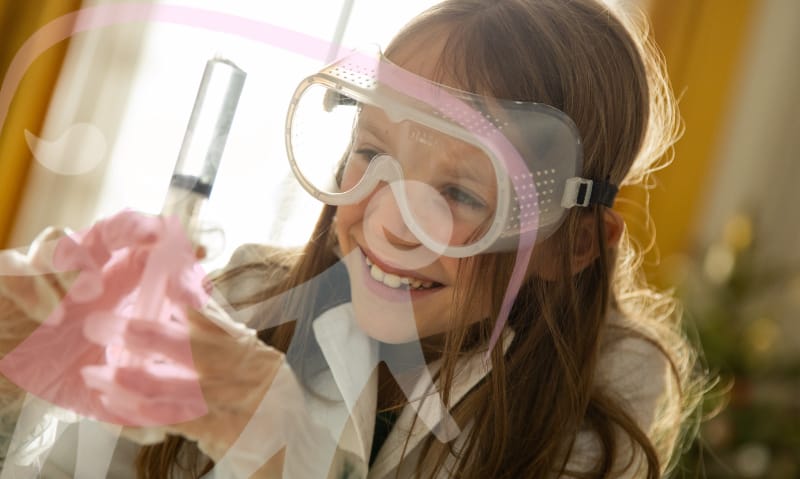4 Fun Tooth-related Science Experiments for Kids

Have fun while learning about your teeth!
Are you looking for fun and engaging ways to get your kids excited about their dental health? Science experiments can be a great way to keep their attention and offer hands-on exploration.
These fun ideas can help you turn abstract ideas into tangible, real-world concepts that even the littlest chemists can grasp. Today, we’re sharing 5 of our favorite tooth-related science experiments, so you can turn your kitchen into a test lab today!
1. Elephant Toothpaste
This experiment is sure to bring out lots of “wows” from your crew! If they think brushing their own teeth is fun, think about how much toothpaste a huge elephant must use! This is one of our favorite science experiments for kids, and it’s always a big hit at home.
To create this oversized concoction, you’ll need to mix hydrogen peroxide with dish soap in one bowl. In another, you should mix dry yeast and warm water. When you combine the two mixtures, the result is an out-of-this-world “toothpaste” full of bubbles and foam.
You can even make the toothpaste colorful or striped by adding a few drops of food coloring to the peroxide and soap mixture. The full set of instructions can be found here. Be sure to do this one outside, where the paste has plenty of room to grow!
2. Bacteria “Tablets”
Plaque can be a difficult concept to explain to kids, especially because it can be hard to spot on their teeth. They’re at an age where they need to see to believe (except for the Tooth Fairy, of course!).
To encourage them to brush it away, try a simple experiment using disclosing tablets.
When your little ones chew these tasteless tablets, the plaque in their mouths will turn bright colors. This will give them a visual representation of where it’s clinging to their teeth so they can better understand the importance of good oral hygiene!
Some tablets will stain old plaque one color and new plaque another. The colors are temporary and wash away with gentle brushing and flossing, but the impactful reminder will last.
3. Eggs in Vinegar
Do your children understand how tooth decay can lead to cavities? While they may know to avoid a bunch of sugary sweets, they might not fully grasp why they need healthy teeth.
To explain the concept of tooth decay, try the classic Eggs in Vinegar experiment. This one explains how bacteria in your mouth produce acids that dissolve the calcium in your tooth enamel.
Start by hard-boiling a few eggs. Explain to your children that the hard outer shell protects the soft inside of the egg, much like our enamel protects the soft tissue (dentin) in our teeth. Leaving the shells on, place the eggs in cups of vinegar and cover the tops with plastic wrap to keep out any air.
Ask your kids to hypothesize what they think will happen. Will the vinegar eat away at the shell? Or will it stay intact?
On day one, you may not find much besides bubbles. Check back in a few days, however, and you’ll find that the shell is soft and pitted and may even be completely dissolved in some places. Reassure your children that the process takes much longer on their teeth and that brushing and flossing can keep that acid at bay!
4. Plaque Attack
Still have some dry yeast left over from the Elephant Toothpaste experiment? You can put it to good use with this fun Plaque Attack activity! This is a fun and exciting way to explain how sugars in our mouth can create plaque.
Start with two small plastic cups. In each cup, add two teaspoons of yeast. Then, stir one cup of warm water into each cup. Finally, add one tablespoon of sugar to one cup only.
Stir each mixture, then sit back and watch what happens. The cup without the sugar won’t show much activity, but the sugary version will grow a disgusting glob of brown foam!
To achieve the best results, make sure your water is warm, but not too hot. This way, it will fully activate the yeast and create the best, bubbliest Plaque Attack possible! Remind your kids that this reaction won’t happen in their mouth if they take care of their teeth and gums at home.
Try these tooth-related science experiments today!
Kids learn by doing and participating. This is true whether they’re playing outside or working in the classroom. If you’re looking for a new and interesting way to get them excited about dental health, these tooth-related science experiments are super fun!
Learn alongside them, encourage their work, and answer any questions they might have. Together, you can learn healthy habits that can keep their teeth and gums looking and feeling great for life.
Along the way, our dental team is here to help supplement and support your lessons. Contact us today to schedule an appointment!